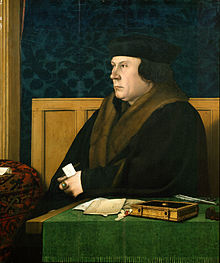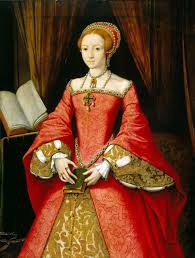Elizabeth: Her Mother’s Memory
Elizabeth at the age of two years and eight months upon the death of her mother, probably never had concrete recollections of her mother Anne Boleyn. There is no evidence that Anne Boleyn was mentioned by any of Elizabeth’s household members during her childhood. It is pure speculation as to which adults told the youngster about her mother and when she would have possibly learned about Anne’s execution and the scandalous reasons for it. There are plenty of assumptions that Henry had placed a moratorium on the subject of Anne Boleyn which would not be implausible, but what is conjecture is based on the fact that Elizabeth was confined to her estate because Henry could not bear the sight of her and wanted no remembrance of her or her mother. We know Sir John Shelton assured Cromwell on Wednesday 16 August 1536 from Hunsdon that he would ensure “the King’s pleasure that my lady Elizabeth shall keep her chamber and not come abroad, and that I shall provide for her as I did for my lady Mary when she kept her chamber” (Gairdner XI 312). We know Elizabeth remained secluded at Hunsdon; we just do not know why—it could have been Henry trying to protect her from court gossip.
Lady Bryan, in August 1536, had already questioned Cromwell on the status of her charge. “Now, as my lady Elizabeth is put for that degree she was in, and what degree she is at now, I know not but by hearsay, I know not how to order her or myself, or her women or grooms” (Gairdner XI 203). Obviously, there was some confusion in her household. Even Elizabeth was confused; when a gentleman of her household, often identified as either Sir John Shelton or Sir Thomas Bryan, referred to her by the demoted title of Lady Elizabeth, she responded “how haps it, Governor, yesterday my Lady Princess, and today but my Lady Elizabeth?” (Hibbert 20). An astute child such as this would have understood the danger of asking questions about her mother or even mentioning her.
There are only two recorded times when Elizabeth mentioned her mother in public. One was when she was 20 and hinted to the Spanish ambassador that she was disliked by Mary because of the distress her mother had caused. The second was when she informed the Venetian ambassador that her mother would never have cohabitated with the king without the ties of matrimony (Weir The Children of Henry VIII 7). Is this anemic display evidence that she did not have any feelings for her mother or that she did not want to be associated with Anne? Probably not. It would not have been politically wise for Elizabeth to be linked too often and too closely with Anne Boleyn so one can understand the lack of mention by an aware and intelligent child. This did not mean complete elimination of connections and when she was more secure as queen, several examples are in evidence of her identification with her mother although the earliest example comes when she was about ten.
This early example was when she wore the ‘A’ necklace in the painting, “The Family of Henry VIII.” Supposedly this was “one of Anne Boleyn’s initial pendants” that was inherited from Elizabeth’s mother (Weir Lady in the Tower 306).
Jewelry was one way that Elizabeth showed her relationship with her mother.
Anne Boleyn was said to have three pendants of initials; an “A”, a “B”, and an “AB”. The “B” necklace is the most famous and is in portraits displayed at the National Portrait Gallery and Hever Castle more readily validated as representative of Anne. The “AB” is perhaps in a less famous painting; one not completely authenticated as Anne, and is referred to as the Nidd Hall portrait.
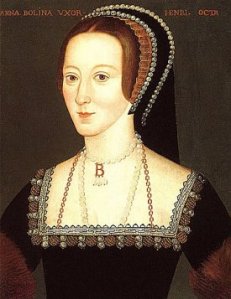
Anne Boleyn, National Portrait Gallery
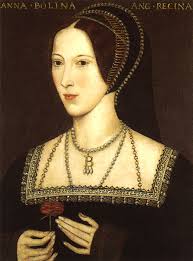
Anne Boleyn, ‘Hever Castle Portrait’ a copy of the lost original painted in 1534
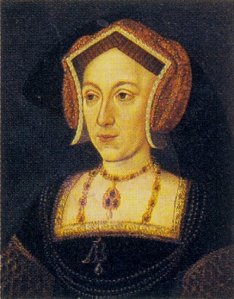
Anne Boleyn, ‘Nidd Hall Portrait’ with the pendent of ‘AB’ hanging upon her gown
It is claimed that Elizabeth was wearing the “A” necklace in “The Family of Henry VIII” painting that hung in Hampton Court. (Weir Henry VIII: The King and His Court 187). This blogger must disagree with some reports that she was wearing the necklace in defiance of her father. He had full control of all of his public imagery. I cannot imagine the artist risking his life, quite literally, by painting in the “A” if it was not sanctioned by Henry. It is hard to imagine that Elizabeth would so blatantly wear this piece of jewelry without Henry’s permission. This blogger could start an unsupported theory that this could be the cause of Elizabeth’s exile from 1543 to 1544 (see blog entry “The Fourth Step-Mother of Elizabeth, Katherine Parr” at https://elizregina.com/2013/06/04/the-fourth-step-mother-of-elizabeth-katherine-parr/). This is clearly on a weak foundation considering the painting, according to Roy Strong, was completed between 1543 -1547. If Henry became incensed enough to banish his daughter for wearing an inherited item of jewelry from her disgraced mother, surely he would have ordered it painted out of the completed picture. Perhaps allowing Elizabeth to display this necklace was a kind gesture on the king’s part or it was a tactic wanting everyone to associate the girl with her mother and her illegitimacy, in contrast to the legitimate heir next to him.
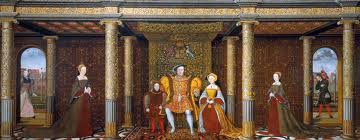
The Family of Henry VIII
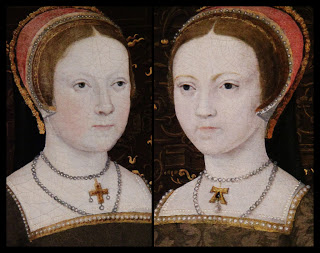
An enlargement obtained by Flickr of the princesses
Apart from the wearing of one of Anne Boleyn’s necklaces, another piece of jewelry associated with Elizabeth and her mother is the Chequers ring. Dated to around 1575 the Chequers Ring, thus named as it is now in the possession of that estate, clearly has a diamond encrusted ‘E’ and ‘R’ on the face. The locket opens to reveal a portrait of Elizabeth and an unidentified woman, usually and logically identified as Anne Boleyn; although, speculation ranges from it being a younger Elizabeth to Katherine Parr. The history of the ring is too sketchy for this blogger to comfortably say that Elizabeth commissioned it as opposed to a courtier. It is also difficult to agree with Weir, and many other writers who claim the ring “was only removed from her finger at her death, when it was taken to her successor, James VI of Scotland, as proof of her demise” (Weir Lady in the Tower 306). There is no definitive proof that Elizabeth constantly wore the ring or that it was the particular jewel taken to Scotland by Robert Carey.
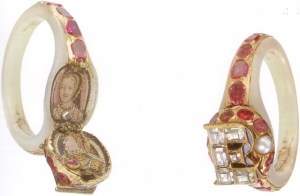
Chequers ring–this blogger was fortunate to see this locket ring at “Elizabeth: The Exhibition at the National Maritime Museum” in Greenwich on August 8, 2003.
Another way Elizabeth linked to her mother was the use of her mother’s heraldic badge the crowned falcon upon a tree stump, surrounded by Tudor roses. Although this was not implemented consistently as Elizabeth’s badge, there are several places it is displayed and on several items such as her virginal. The spinet “bears the royal coat of arms and the falcon holding a scepter, the private emblem of her mother, Anne Boleyn” (“The Queen Elizabeth Virginal”). It is also speculated that Elizabeth adopted one of Anne’s mottoes, Semper eadem. This is discussed on the blog “Said it, Believed it, Lived it” at https://elizregina.com/2013/06/25/said-it-believed-it-lived-it/.
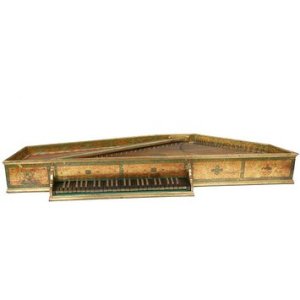
Virginal of Elizabeth I, the Boleyn badge is on the left.
Elizabeth continued her links with her mother by promoting members of Anne’s household staff, Matthew Parker as Archbishop of Canterbury and relatives; notably the Careys, Knollyse, Sackvilles and even Howards until their alliance to Catholicism made it politically impossible. Anne was also commemorated in a biography by William Latymer and in an unfinished treatise by George Wyatt (Weir, The Lady in the Tower 307-308).
A way in which Elizabeth kept her mother’s influence alive was in her understanding of the benefits and necessity of display. “Between Anne and Elizabeth there was an uncanny similarity of attitude towards the projection of monarchy, and of themselves as chosen by God to rule” (Ives 218). It is estimated Anne spent £40* a month mostly on clothes for herself and Elizabeth (Ives 217). Had Anne lived, her wardrobe would have “rivalled the 2000 costumes which tradition assigns to that most fashion-conscious of monarchs, her daughter Elizabeth” (Ives 253). Catholic chronicler, Nicholas Sander, no friend of Anne’s, conceded that she “was always well dressed, and every day made some change in the fashion of her garments” (Sander 25).
Anne has been criticized for having such an active interest in her daughter’s wardrobe; one wonders if this was an area in which she could direct her wishes and so she did. Taking an inordinate amount of care in the purchase of materials and the ordering of garments for her child was perhaps the method of bestowing attention that was socially and politically acceptable for Anne.
We have a dispatch that Sir William Loke, mercer and merchant adventurer who supplied the king with clothes of gold, silver and other luxurious fabrics and performed diplomatic missions on his buying trips abroad, wrote personally to the king in February 1534: “The sale of cloths by your subjects has been good, but money is scarce. I trust I have done my best to provide such things as the Queen gave me commission for” (Gairdner VIII 197). Loke kept extensive account records (published in the text, An Account of Materials Furnished for Use of Queen Anne Boleyn and the Princess Elizabeth, by William Loke ‘the King’s Mercer’ Between the 20th January 1535 [27th year of Henry VIII], and the 27th April 1536. Communicated by J. B. Heath) which reveal clothing being sent to the princess. It was obvious that the “king’s heir, who was not yet three years old, was quite properly to be dressed in fashionable and expensive clothing” (Warnicke 170).
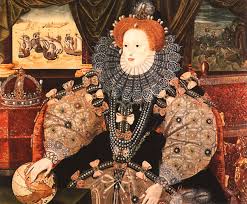
An example of elaborate clothing worn by Elizabeth in the ‘Armada Portrait’.
In Anne’s account books of May 19, 1536, are entries for payment for “boat-hire form Greenwich to London and back to take measure of caps for my lady Princess, and again to fetch the Princess’s purple satin cap to mend it.” Anne, apparently, was especially fussy about her daughter’s caps: this particular one required at least three journeys to Greenwich to get it right” (Ives 253). Included in the accounts was “an ell of ‘tuke’ and crimson fringe for the Princess’s cradle head.” Added to this finery was “a fringe of Venice gold and silver for the little bed.” Included were more assorted caps, white, crimson, purple and a “cap of taffeta covered with a caul of damask gold for the Princess” (Gairdner X 913).
Queen Anne Boleyn never had a full say in her child’s upbringing. That was the business of the king and his council. Famously, when it came to decide if Elizabeth should be weaned, her governess wrote to Thomas Cromwell for permission (Warnicke 170). We do know from William Latymer, chaplain to Anne Boleyn who wrote Chronickille of Anne Bulleyne during the reign of Elizabeth, reported that Anne “had wanted her child, as her elder half-sister had been, trained in classical languages” (Warnicke 171). When Anne realized that she was in serious danger of losing her life she gave unto Matthew Parker, her devoted chaplain and later Archbishop of Canterbury during the reign of Elizabeth, the care of her child. This move can be seen as her wish for Elizabeth to have not only a classical education but also a more evangelical religious upbringing.
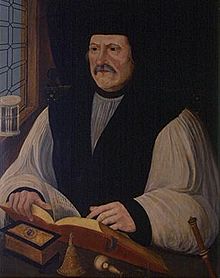
Matthew Parker, Archbishop of Canterbury during the reign of Elizabeth
Besides directing Elizabeth’s wardrobe and directing her education, how else did Anne bestow attention on her daughter? This is impossible to know. Following standards of the day, Elizabeth was removed from her parents’ household when she was three months old. She was sent to her own residence, Hatfield, with a wet-nurse and her governess, Margaret Bourchier, Lady Bryan. “Here and at Hunsdon in Hertfordshire the princess spent much of her childhood although, like her parents, she traveled from house to house, staying in such places as Richmond, Eltham, Langley,and the More” (Warnicke 170). Contemporary records indicate that Anne did visit regularly as we see from a letter written by Sir William Kyngston, courtier and Constable of the Tower of London, to Lord Lisle, Arthur Plantagenet on 18 April 1534. “To day the King and Queen were at Eltham, and saw my lady Princess, as goodly a child as hath been seen and her grace is much in the King’s favour as goodly child should be, God save her” (Gairdner VII 509).
The visits were not always private, as we would assume between a mother and her child as Eustace Chapuys mentions in a dispatch to Charles V on 24 October 1534. “On Thursday, the day before yesterday, being at Richmond with the little lass (garce) the Lady came to see her said daughter, accompanied by the dukes of Norfolk and Suffolk and others, including some of the ladies, which was a novelty” (Gairdner VII 1297). Besides these visits, Anne was in contact with Lady Bryan through letters concerning the care of Elizabeth (Ives 256). A response to a request from Elizabeth’s household officers to the Council was sent in a packet with “letters to them, and one from the Queen to lady Brian” (Gairdner IX 568).
Speculation is futile regarding the feelings both mother and daughter felt for each other; no written records exist. Anne, following the social dictates and court etiquette of the day, rarely saw her daughter. Not only was Elizabeth reared by people other than her parents, she was physically removed from them, as was her siblings so some people placing emphasis on the fact she was taken to Hatfield at the age of three months was proof her mother was as disappointed as her father in her birth. Henry’s treasured heir, Edward, was also reared in a separate household. Evaluation of those persons surrounding the infant Elizabeth does lend itself to assume a strong influence of Anne. Many had Boleyn connections: Lady Margaret Bryan was not only Princess Mary’s former governess but related to Anne as they shared a maternal grandmother; Lady Shelton, also from Princess Mary’s household and given charge of the combined establishment of Mary and Elizabeth was Anne’s Aunt; and Kat Ashley nee Champernowne was married to Anne’s cousin. After Anne Boleyn’s execution, Henry did not alter the positions of these people closest to Elizabeth. He too must have trusted them and was not worried about how Anne would be portrayed to their daughter by ‘Boleyn’ servants. Elizabeth would later comment that “we are more bound to them that bringeth us up well than to our parents… our bringers-up are a cause to make us live well in [the world]” (Marcus 34).
*£40 from 1535 would be £19,000.00 using the retail price index or£266,000.00 using average earnings based on calcualtions from the “Measuring Worth” website.
References:
Brewer, J. S. (editor). “Henry VIII: November 1517.” Letters and Papers, Foreign and Domestic, Henry VIII, Volume 2: 1515-1518 (1864): 1183-1198. British History Online. Web. 29 June 2013.
Burnet, Gilbert. The History of the Reformation of the Church of England. Vol.I Part I. London: W. Baynes and Son, 1825. Google Books. Web. 3 July 2013.
Gairdner, James. (editor). “Henry VIII: April 1534, 16-20.” Letters and Papers, Foreign and Domestic, Henry VIII, Volume 7: 1534 (1883): 199-210. British History Online. Web. 29 June 2013.
Gairdner, James (editor). “Henry VIII: February 1535, 11-20.” Letters and Papers, Foreign and Domestic, Henry VIII, Volume 8: January-July 1535 (1885): 75-98. British History Online. Web. 29 June 2013.
Gairdner, James (editor). “Henry VIII: October 1535, 6-10.” Letters and Papers, Foreign and Domestic, Henry VIII, Volume 9: August-December 1535 (1886): 181-195. British History Online. Web. 29 June 2013.
Gairdner, James (editor). “Henry VIII: February 1536, 1-5.” Letters and Papers, Foreign and Domestic, Henry VIII, Volume 10: January-June 1536 (1887): 82-98. British History Online. Web. 01 July 2013.
Gairdner, James (editor). “Henry VIII: August 1536, 16-20.” Letters and Papers, Foreign and Domestic, Henry VIII, Volume 11: July-December 1536 (1888): 130-138. British History Online. Web. 28 June 2013.
Hibbert, Christopher. The Virgin Queen: Elizabeth I, Genius of the Golden Age. New York: Addison-Wesley Publishing Company, Inc., 1991. Print.
Ives, Eric. The Life and Death of Anne Boleyn: The Most Happy. Oxford: Blackwell Publishing, 2004. Print.
Marcus, Leah S. et al., eds. Elizabeth I: The Collected Works. Chicago: University of Chicago Press, 2002. Print.
“The Queen Elizabeth Virginal.” V&A Images Collection. Victoria and Albert Museum, n.d. Web. 03 July 2013.
Ridgway, Claire. The Fall of Anne Boleyn: A Countdown. UK: MadeGlobal Publishing, 2012. Print.
Sander, Nicholas, and Edward Rishton. Rise and Growth of the Anglican Schism. Trans. David Lewis. London: Burns & Oates, 1877. Google Books. Web. 28 June 2013.
Somerset, Anne. Elizabeth I. New York: Alfred A. Knopf, 1991. Print.
Warnicke, Retha. The Rise and Fall of Anne Boleyn: Family Politics at the Court of Henry VIII. Cambridge: Cambridge University Press, 1989. Print.
Weir, Alison. The Children of Henry VIII. New York: Ballantine Books, 1996. Print
Weir, Alison. Henry VIII: The King and His Court. New York: Ballatine Books, 2001. Google Books. Web. 30 June 2013.
Weir, Alison. The Lady in the Tower: The Fall of Anne Boleyn. London: Jonathan Cape, 2009. Print.

